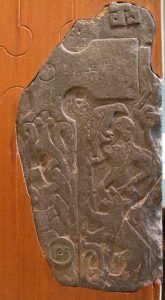Manx crosses of the tenth-century Scandinavian settlement
Prof. Sir David M. Wilson
6.00-7.00pm, Main Hall, University College Isle of Man (free admission, no booking required)
The image provided by the handsome, bearded Vikings who sometimes inhabit the quay in Peel is splendid theatre; but, as the actors are well aware, is no true image – and not merely because they all seem to wear horned helmets which no self-respecting Viking would be seen dead in. David Wilson’s lecture provides a truer picture of the Scandinavians who settled in the Isle of Man in the course of the tenth century and whose presence led to the foundation of the Norse kingdom of Man and the Isles, which is the ultimate reason for the Island’s semi-independent status today.
The picture which he will provide is of a sophisticated and reasonably wealthy group of settlers, who took land here and formed a powerful force in the troubled political events which took place in the lands around the Irish Sea and who were also influential in the Western and Northern Isle of Scotland, Events which influenced action from far-away Norway.
Through the remarkable and competently ornamented stone memorial sculpture raised by the earliest settlers, it is possible to tell the story of land-taking and of the settlers’ ultimate origins in Scandinavia. The sculptured crosses also tell of their conversion to Christianity and of the process by which they achieved it. The crosses show how the gods and heroes of the North were used as part of this process – as illustrations in the sermons delivered on their road to conversion. The runic inscriptions, in Norwegian runes, on the stones tell of gradual nature of the conversion and of such social influences as intermarriage, and of some settlers who adopt Gaelic names.
The crosses – unique to the Island – also illustrate something of the wealth and social fabric of the Island in the tenth century, as the two peoples – Manx and Scandinavian – gradually drew together. This was a period of great turbulence in the lands around the Irish Sea and in the Scottish Islands and Norway, in all of which the inhabitants of the Island took part – sometimes successfully, sometimes disastrously. But most of all the memorials tell of a sophisticated society, illuminated by the skill of whose sculptors was equal to – if different from – the art of North-West Europe.
Sir David Wilson lives in Castletown and is a leading specialist in the art and archaeology of the Viking Age. His book on early Manx sculptures is published by Manx National Heritage.
Back to the 2017-18 Lecture Series.

